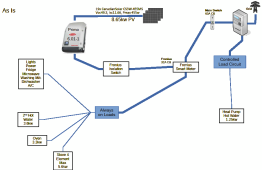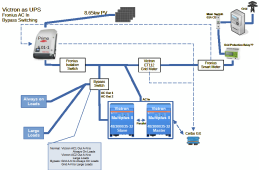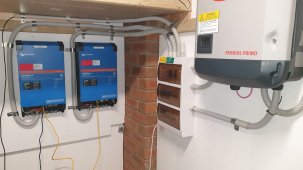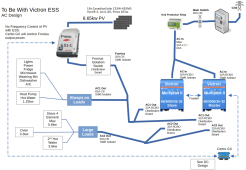Good Idea mate I will. Since its going to be CAT6 will pull a few pairs through. It will all be in conduit as well. I also have to pull through a few cables to do what I want to do with the ESS system.Do yourself a favor and pull 2 or 3 runs. You never know when those extra ones may come in handy and you dont wanna have to dig up again if you drop it in a trench....
You are using an out of date browser. It may not display this or other websites correctly.
You should upgrade or use an alternative browser.
You should upgrade or use an alternative browser.
Grid Tie Victron ESS with DIY LiFePO4 Battery in Australia - Regulatory Issues?
- Thread starter BipedalPrimate
- Start date
Ghosty
New Member
Hi All,
Sorry for the late late late reply the mate of a mate never turned up, didnt want a bar of it....Good news is there is a post on the vic community forum that says the CEC approval is about 4weeks off. So Mid Sept23 we should be good to go....well in a couple months anyway.
In the mean time consider this....
Dont connect the M2 to the grid at ALL, use your fronus on out1 and use the frequency shift function to throttle down the output of the Fronus (or the modbus over TCIP function).
In the Cerbo Gx, utilize the Generator function through a relay and a contactor, switch on a 20Amp 48v battery charger when the SOC gets to your desired value. Something Like turn on the charger at 17% SOC and turns off again at 25%....Thus no connection between the grid and the M2 / AC side, but still utilizing the grid as a backup energy source. More chargers in parallel the more backup.
The only thing this installation cant do is provide additional AC power to the M2 in times of high load or temp. But having a second M2 to share the load will solve this problem.
This is not advice at all and in no way telling you this is what you are to do!
Sorry for the late late late reply the mate of a mate never turned up, didnt want a bar of it....Good news is there is a post on the vic community forum that says the CEC approval is about 4weeks off. So Mid Sept23 we should be good to go....well in a couple months anyway.
In the mean time consider this....
Dont connect the M2 to the grid at ALL, use your fronus on out1 and use the frequency shift function to throttle down the output of the Fronus (or the modbus over TCIP function).
In the Cerbo Gx, utilize the Generator function through a relay and a contactor, switch on a 20Amp 48v battery charger when the SOC gets to your desired value. Something Like turn on the charger at 17% SOC and turns off again at 25%....Thus no connection between the grid and the M2 / AC side, but still utilizing the grid as a backup energy source. More chargers in parallel the more backup.
The only thing this installation cant do is provide additional AC power to the M2 in times of high load or temp. But having a second M2 to share the load will solve this problem.
This is not advice at all and in no way telling you this is what you are to do!
Last edited:
Ghosty
New Member
Hi BipedalPrimate,@KangaRooted Installation is scheduled for 26 June.
how did the install on the 26th go, did you get across the line ok?
What Batteries did you use?
BipedalPrimate
New Member
- Joined
- Mar 25, 2022
- Messages
- 63
Installed & even have a Certificate of Electrical Safety so it is all legal.how did the install on the 26th go, did you get across the line ok?
What Batteries did you use?
Batteries are on their way from China - EVE LF280K.
KangaRooted
New Member
I'm not sure I understand. What was installed exactly if the battery is still on its way? Can you share some more info about work completed?
BipedalPrimate
New Member
- Joined
- Mar 25, 2022
- Messages
- 63
The intent was to have all the AC wiring done by an electrician and get a COES for that part because the AC is the most dangerous.What was installed exactly if the battery is still on its way? Can you share some more info about work completed?
So from this:

To this:

The main panel was completely rebuilt & a new sub-panel was installed (see pictures below).


So, until batteries arrive and are installed (by me), the Victron Multi's are operating in pass-thru mode.
Given the delays & problems with getting an electrician to actually do the work, it made more sense (to me at least) to order batteries after successful AC install and COES issued.
Electrician has even offered to come back after battery install to ensure correct labeling and wiring. But because any battery install is Prescribed Electrical Work, a COES can probably not be issued for the battery components.
Including the COES, the work cost AU$3300 which was for 2 electricians for 1.5 days including parts (CB's, Distribution Board, Contactor, Wiring) but excluding Victron equipment & the Grid Protection Relay.
If you are planning a Victron install make sure the electrician verifies cable sizes & wiring with you before and as they install as this one undersized the AC Out 2 cable & CB's because he assumed the label on side of Multi was the current limit - but that value does not take account of any Grid Assist Passthru.
Attachments
Ghosty
New Member
Cheers for the info, Ill try to find a tele NA003.
Champion
Champion
KangaRooted
New Member
Awesome setup!
Thanks very much for sharing.
Do you have to register your battery with the local wholesaler?
If not how come?
One thing I don't understand is the conditions by which you do / or don't need to register. Did the sparky have anything to say about it?
 www.energex.com.au
www.energex.com.au
This has led me to believe that if you are connected to the grid, you need to register - but it's a little ambiguous.
I also acknowledge it probably changes from state to state.
Also, can you just throw that changeover switch or is there a period of "no power" in your house when you flick the switch....
Again, thanks for sharing your setup - it looks like a professional job.
Keep the pics coming when you go to do your battery.
Thanks very much for sharing.
Do you have to register your battery with the local wholesaler?
If not how come?
One thing I don't understand is the conditions by which you do / or don't need to register. Did the sparky have anything to say about it?
Battery storage connections - Energex
Before your system is installed, you will need pre-approval from Energex to connect to the grid. Find out how.
This has led me to believe that if you are connected to the grid, you need to register - but it's a little ambiguous.
I also acknowledge it probably changes from state to state.
Also, can you just throw that changeover switch or is there a period of "no power" in your house when you flick the switch....
Again, thanks for sharing your setup - it looks like a professional job.
Keep the pics coming when you go to do your battery.
BipedalPrimate
New Member
- Joined
- Mar 25, 2022
- Messages
- 63
Don't know - there was an initial application for the PV & Fronius which could have included a battery, but didn't. As I am not intending to feed the grid from the battery nor from the Victron's, this design is effectively a battery & inverters plugged into a power point with a Grid Protection Relay to intentionally island.Do you have to register your battery with the local wholesaler?
Not a word & seemed nonplussed by the intended design.Did the sparky have anything to say about it?
Changeover switch is 3 position so there is a period of no power when using it.can you just throw that changeover switch or is there a period of "no power" in your house when you flick the switch...
The intended use cases are such that a 10 second period of no power can be managed - there is no life support equipment installed (yet)
Snapperhead
New Member
Any update ? How did you go ?@KangaRooted Installation is scheduled for 26 June.
Snapperhead
New Member
Great setup…. With that setup in the diagram. What occurs when there is a grid fail ? Does the fronius continue to invert etc ? Do your loads continue to be powered ? How will the battery’s change this in a grid fail (i.e. will fronius still charge them and share loads) and did you need to use any ESS setup ? If so what codes were best ? …. Sorry for multiple Barrell qns, but my new setup is almost identical here in Central Victoria Australia and I’m trying to get my head around it all ??????The intent was to have all the AC wiring done by an electrician and get a COES for that part because the AC is the most dangerous.
So from this:
View attachment 162631
To this:
View attachment 162634
The main panel was completely rebuilt & a new sub-panel was installed (see pictures below).
View attachment 162632View attachment 162633
So, until batteries arrive and are installed (by me), the Victron Multi's are operating in pass-thru mode.
Given the delays & problems with getting an electrician to actually do the work, it made more sense (to me at least) to order batteries after successful AC install and COES issued.
Electrician has even offered to come back after battery install to ensure correct labeling and wiring. But because any battery install is Prescribed Electrical Work, a COES can probably not be issued for the battery components.
Including the COES, the work cost AU$3300 which was for 2 electricians for 1.5 days including parts (CB's, Distribution Board, Contactor, Wiring) but excluding Victron equipment & the Grid Protection Relay.
If you are planning a Victron install make sure the electrician verifies cable sizes & wiring with you before and as they install as this one undersized the AC Out 2 cable & CB's because he assumed the label on side of Multi was the current limit - but that value does not take account of any Grid Assist Passthru.
BipedalPrimate
New Member
- Joined
- Mar 25, 2022
- Messages
- 63
When grid fails, batteries will supply loads because loads are on AC Out of Multis.What occurs when there is a grid fail ? Does the fronius continue to invert etc ? Do your loads continue to be powered ? How will the battery’s change this in a grid fail (i.e. will fronius still charge them and share loads) and did you need to use any ESS setup ? If so what codes were best ?
Because it is on AC In side of Multis, Fronius will get its grid forming signal from the grid and will not generate any power during grid fail.
I had originally planned, and may do later, to have the Fronius on AC Out 1 of the Multis allowing it to generate power during grid failure but that would mean allowing the Multis to feed back surplus power to the grid. Given Multis do not seem to have CEC approval to feed back to grid, it feels prudent to design accordingly.
ESS will be used.
Last edited:
Hey Ghosty, any word on how this went? I'm keen to setup the below ESS but with the ability to feed back into the grid... also understand I need the Tele Grid Protection device...there is a post on the vic community forum that says the CEC approval is about 4weeks off. So Mid Sept23 we should be good to go....well in a couple months anyway.
Attachments
Awesome setup and I was keen to replicate until l I found out the problems listed in the forum.Installed & even have a Certificate of Electrical Safety so it is all legal.
Batteries are on their way from China - EVE LF280K.
Could you share with us which Grid Protection Relay you went with please and the cost?
Thank you
edit: zoomed into your install photo and I can see TELE NA003
Last edited:
davidpb153
New Member
Hi @BipedalPrimate. Going back a bit. Hope you still come back to answer this.When grid fails, batteries will supply loads because loads are on AC Out of Multis.
Because it is on AC In side of Multis, Fronius will get its grid forming signal from the grid and will not generate any power during grid fail.
I had originally planned, and may do later, to have the Fronius on AC Out 1 of the Multis allowing it to generate power during grid failure but that would mean allowing the Multis to feed back surplus power to the grid. Given Multis do not seem to have CEC approval to feed back to grid, it feels prudent to design accordingly.
ESS will be used.
It's so cool that you got this working.
One thing that I don't quite get from your diagram and description is the point of the grid protection relay.
My understanding (likely wrong):
- Configuration (simplify - assume no solar), where Multi can feedback to grid (dependent on Software Settings):
- Grid -> main Switch -> AC in of Multi -> Ac out of Multi -> Loads
- Configuration (simplify - assume no solar) where Multi cannot feedback to grid due to the grid protection relay (regardless of Software settings)
- Grid -> main Switch -> Grid Protection Relay -> AC in of Multi -> Ac out of Multi -> Loads
- Grid -> main Switch -> Grid Protection Relay -> AC in of Multi -> Ac out of Multi -> Loads
- Configuration where Solar can feedback to grid (solar or grid can charge Multi), but Multi cannot due to grid protection relay (regardless of Software settings):
- Grid -> main Switch -> Fronius -> Grid Protection Relay -> AC in of Multi -> Ac out of Multi -> Loads
- Grid -> main Switch -> Fronius -> Grid Protection Relay -> AC in of Multi -> Ac out of Multi -> Loads
- What you've drawn is:
- Grid -> main Switch -> Grid Protection Relay -> Fronius -> AC in of Multi -> Ac out of Multi -> Loads
Isn't it software settings that determine if the multi can feedback to the grid? If simply connecting the grid to the AC in of the multi is enough to prevent feedback to the grid, why is a grid protection relay necessary? Or is it only in the case of a grid outage that there is an issue with feedback?
BipedalPrimate
New Member
- Joined
- Mar 25, 2022
- Messages
- 63
I can't see how Fronius can feedback to grid if the grid protection relay is setup to prevent feedback
The Grid Protection Relay does not prevent feedback to grid - it only ensures that the Voltage & frequency in either direction meets the requirements of the configured grid code standard.
If any of voltage or frequency falls outside of the parameters, the grid is disconnected until they come within the parameters.

So the Grid Protection Relay provides a layer of protection in addition to that the Victron & Fronius inverters provide.
This is required because the Victron inverters have not been certified to AS/NZS 4777.2:2020.
With this design, the Victron inverters COULD feedback to grid because the Grid Protection Relay ensures grid quality voltage/frequency but I have chosen not to at this stage.
Last edited:
davidpb153
New Member
Thanks for clarifying, that's what I understood. I was wondering if there was an issue in that you technically can still feedback using the inverters even though they aren't CEC certified.The Grid Protection Relay does not prevent feedback to grid - it only ensures that the Voltage & frequency in either direction meets the requirements of the configured grid code standard.
If any of voltage or frequency falls outside of the parameters, the grid is disconnected until they come within the parameters.
So the Grid Protection Relay provides a layer of protection in addition to that the Victron & Fronius inverters provide.
This is required because the Victron inverters have not been certified to AS/NZS 4777.2:2020.
With this design, the Victron inverters COULD feedback to grid because the Grid Protection Relay ensures grid quality voltage/frequency but I have chosen not to at this stage.
It would be nice to be able to choose to feedback to the grid with this setup (and more batteries); with Amber/Home Assistant, could probably start getting a better ROI on the batteries.
Really appreciate the design. Next time getting switchboard work when extending the house, I'll try to get something similar at the same time.
Snapperhead
New Member
Am I correct in assuming that Victron now had CEC approval in Australia for the MP II grid code A/477.2:2020 with new Appendix M approval ???
I assume this due to the details within the changelog of the MP Firmware 510 that states >>>
**Enabled the appendix M. gridcodes of AS/NZS4777 for standard Multis/Quattros.
(installation requires external IP)**
I assume this due to the details within the changelog of the MP Firmware 510 that states >>>
**Enabled the appendix M. gridcodes of AS/NZS4777 for standard Multis/Quattros.
(installation requires external IP)**
Animalector
New Member
- Joined
- Sep 19, 2020
- Messages
- 7
Nothing on CEC website yet, but this would be good, I am looking to go with a Multiplus, but legal connection is a problem in Australia.Am I correct in assuming that Victron now had CEC approval in Australia for the MP II grid code A/477.2:2020 with new Appendix M approval ???
I assume this due to the details within the changelog of the MP Firmware 510 that states >>>
**Enabled the appendix M. gridcodes of AS/NZS4777 for standard Multis/Quattros.
(installation requires external IP)**
One thing that confused me about this whole scenario was why wouldn't Victron seek certification as multimode inverters? I don't think it was a marketing decision because the way it stands, even in a mobile situation you could not connect the Multiplus II 48's to shore power. Now I know the majority of those systems are 12 or 24V which don't appear on the CEC list at all. Does "grid connected" only count if they are permanently connected?
wattmatters
Solar Wizard
I'd have thought that would apply to generation source which has the potential to energise the grid.Does "grid connected" only count if they are permanently connected?
Might be misunderstanding - you are allowed to connect the Multiplus II 48V's to a generation source on the input. You are not allowed to connect the input to the grid (currently). That's my understanding. That *may* be changing if that firmware note above is accurate and Victron have applied for the appropriate CEC approval. But no one should base a purchasing decision on what may happen.I'd have thought that would apply to generation source which has the potential to energise the grid.
wattmatters
Solar Wizard
That's a bit of a confusing description.Might be misunderstanding - you are allowed to connect the Multiplus II 48V's to a generation source on the input. You are not allowed to connect the input to the grid (currently). That's my understanding. That *may* be changing if that firmware note above is accurate and Victron have applied for the appropriate CEC approval. But no one should base a purchasing decision on what may happen.
What do you mean by "input", input to the grid or input to the inverter? For some devices they are one and the same thing. If the connection to the grid has the potential to energise the grid, then that is the concern.
My inverter has an AC input but presents as a load only, it cannot energise the grid.
wattmatters
Solar Wizard
I think we have crossed lines. I'm not talking about what it is is/not permitted but rather what it is capable of.Referring to the AC input side of the inverter - atm it's classified as Generator input only and has the restriction of not being able to feed back to the grid.
Some inverter AC inputs are incapable of energising the circuit is supplying them. For them power can only flow in one direction and they can only ever present as a load. As far as the grid is concerned these are no different to a fridge or a hair dryer.
Others however have an AC input which is capable of being bidirectional. It may well be possible in the inverter's settings for it to be set not do so, however it has the capability of energising the grid.
Similar threads
- Replies
- 7
- Views
- 496
- Replies
- 1
- Views
- 234
- Replies
- 1
- Views
- 378
- Replies
- 0
- Views
- 453




